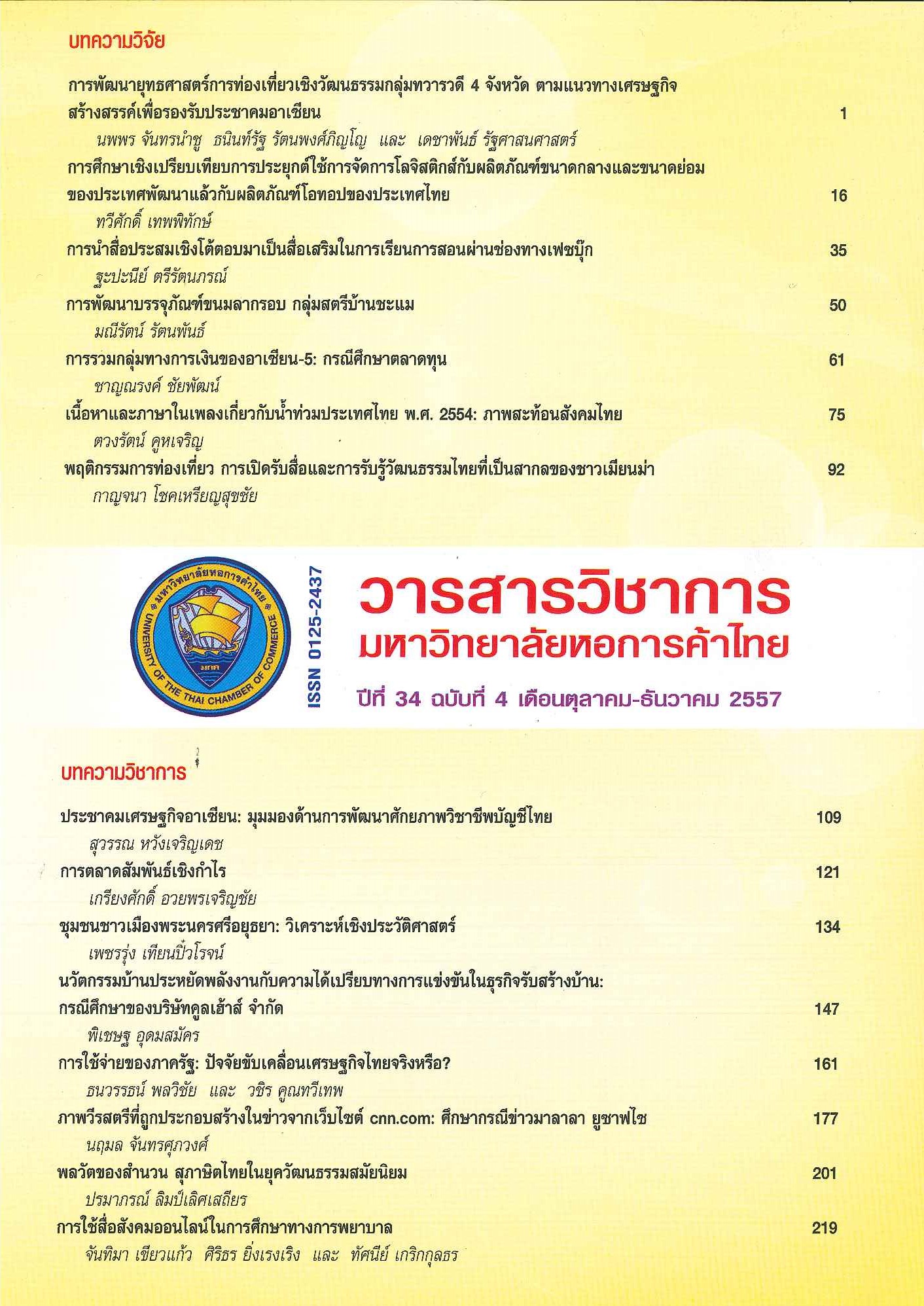ASEAN-5 Monetary Integration: a Case Study of Equity Markets
Main Article Content
Abstract
Economic integration is a current worldwide trend. In particular, in 2015 under the ASEAN Economic Community the third stage of economic integration - a single common market of ASEAN countries - will officially be implemented. Factors of production, products, services and labor can freely be mobilized between the ASEAN member countries. Later, ASEAN should aim to reach the higher stage of economic integration, which is monetary integration. It will be a key to link international business transactions and to support integration of economic real sectors to become more successful. According to the optimum currency area theory, it is indicated that countries sharing a single currency must have compatible economic variables. This article aims to examine the synchronicity of financial variables in ASEAN-5 by using equity market indices collected during the period from January 2003 to June 2013. Using the Cointegration test to analyze the data, the results reveal 8 pairs (out of 10 pairs) of cointegration relationships among ASEAN-5 markets indices, which include the markets of Malaysia and Indonesia, the Philippines and Indonesia, the Philippines and Malaysia, Singapore and Indonesia, Singapore and Malaysia, Singapore and the Philippines, Thailand and Malaysia, and Thailand and the Philippines. The results of analyzing for error correction mechanism show that when there are deviations from equilibrium, the eight pairs of ASEAN market indices will adjust to the long-run equilibrium with a positive relationship. As for the Thailand-Indonesia and Thailand-Singapore market indices, no long-run equilibrium is found. This study shows that most of the variables in equity markets of ASEAN-5 are symmetric and this will support the monetary integration of ASEAN-5 in the future.
Article Details

This work is licensed under a Creative Commons Attribution-NonCommercial-NoDerivatives 4.0 International License.
ลิขสิทธิ์ของบทความ
ผลงานที่ได้รับการตีพิมพ์ถือเป็นลิขสิทธิ์ของมหาวิทยาลัยหอการค้าไทย ห้ามมิให้นำเนื้อหา ทัศนะ หรือข้อคิดเห็นใด ๆ ของผลงานไปทำซ้ำ ดัดแปลง หรือเผยแพร่ ไม่ว่าทั้งหมดหรือบางส่วนโดยไม่ได้รับอนุญาตเป็นลายลักษณ์อักษรจากมหาวิทยาลัยหอการค้าไทยก่อน
References
ASEAN. 2008. ASEAN Economic Community Blueprint. Jakarta: ASEAN Secretariat.
Benbouziane, M., and Benamar, A. 2010. “Could GCC Countries Achieve an Optimal Currency Area?” Middle East Development Journal 2, 2: 203-227.
Bloomberg. 2014. Asia-Pacific Stock Indexes [Online]. Available: https://https://www.bloomberg.com/markets/stocks/world-indexes/asia-pacific
Chaiphat, C. 2013. “A Comparison of Synchronicity of Macroeconomic Variables: ASEAN – Japan.” University of the Thai Chamber of Commerce Journal 33, 3: 16-31. (in Thai).
ชาญณรงค์ ชัยพัฒน์. 2556. “เปรียบเทียบความสอดคล้องของตัวแปรเศรษฐกิจมหภาค: อาเซียน-ญี่ปุ่น.” วารสารวิชาการ มหาวิทยาลัยหอการค้าไทย 33, 3: 16-31.
Chen, C. W. S., et al. 2009. “The Impact of Structural Breaks on the Integration of the ASEAN-5 Stock Markets.” Mathematics and Computers in Simulation 79: 2654-2664.
Chuku, A. C. 2012. The Proposed ECO: Should West Africa Proceed With A Common Currency? Oxford: The Centre for the Study of African Economies.
Dickey, D. A., and Fuller, W. A. 1981. “Likelihood Ratio Tests for Autoregressive Time Series with a Unit Root.” Econometrica 49,4: 1057-1072.
Engle, R. F. and Granger, C. W. J. 1987. “Cointegration and Error Correction: Representation, Estimation, and Testing.” Econometrica 55, 2: 251-276.
Gupta, R., and Guidi, F. 2012. “Cointegration Relationship and Time Varying Co-Movements Among Indian and Asian Developed Stock Markets.” International Review of Financial Analysis 21: 10-22.
Horvath, J. 2003. Optimum Currency Area Theory: A Selective Review. Helsinki: Bank of Finland, Institute for Economies in Transition.
Jean Louis, R., Brown, R., and Balli, F. 2011. “On the Feasibility of Monetary Union: Does it Make Sense to Look for Shocks Symmetry Across Countries when none of the Countries Constitutes an Optimum Currency Area?” Economic Modelling 28, 6: 2701-2718.
Kenen, P. B. 1969. The Theory of Optimum Currency Areas. Chicago, IL: University of Chicago Press.
Lim, L. 2009. “Convergence and Interdependence between ASEAN-5 Stock Markets.” Mathematics and Computers in Simulation 79: 2957-2966.
Magnifico, G. 1973. European Monetary Unification. New York: Wiley and Sons.
McKinnon, R. I. 1963. “Optimum Currency Areas.” American Economic Review 53, 4: 717-725.
Mundell, R. A. 1961. “A Theory of Optimum Currency Areas.” American Economic Review 51, 4: 657-665.
Pisanwannich, A. 2012. “The Effect of the Asian Economic Community (AEC) on Thai Rice Exports.” University of the Thai Chamber of Commerce Journal 32, 3: 33-57. (in Thai).
อัทธ์ พิศาลวานิช. 2555. “ผลกระทบของประชาคมเศรษฐกิจอาเซียนต่อเศรษฐกิจข้าวไทย” วารสารวิชาการ มหาวิทยาลัยหอการค้าไทย 32, 3: 33-57.
Thao, T. P., and Daly, K. 2012. “The Impacts of the Global Financial Crisis on Southeast Asian Equity Markets Integration.” International Journal of Trade, Economics and Finance 3, 4: 299-304.
Yu, I. W., Fung, K. P., and Tam, C. S. 2010. "Assessing Financial Market Integration in Asia Equity Markets.” Journal of Banking and Finance 34: 2874-2885


